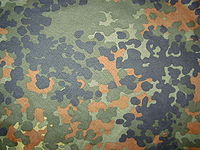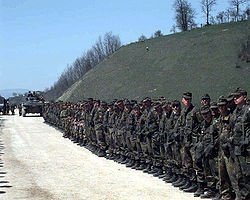
Flecktarn
Encyclopedia


Camouflage
Camouflage is a method of concealment that allows an otherwise visible animal, military vehicle, or other object to remain unnoticed, by blending with its environment. Examples include a leopard's spotted coat, the battledress of a modern soldier and a leaf-mimic butterfly...
pattern. The use of spots creates a "dithering" effect, which eliminates hard boundaries between the different colours in much the same way the squares in the newest digital camouflage patterns do. The pattern is designed for use in temperate woodland terrain. It has been adapted as desert camouflage by varying the colours.
History
The GermansGermany
Germany , officially the Federal Republic of Germany , is a federal parliamentary republic in Europe. The country consists of 16 states while the capital and largest city is Berlin. Germany covers an area of 357,021 km2 and has a largely temperate seasonal climate...
had experimented before World War II
World War II
World War II, or the Second World War , was a global conflict lasting from 1939 to 1945, involving most of the world's nations—including all of the great powers—eventually forming two opposing military alliances: the Allies and the Axis...
, and some army units used "splinter" pattern camouflage. Waffen-SS
Waffen-SS
The Waffen-SS was a multi-ethnic and multi-national military force of the Third Reich. It constituted the armed wing of the Schutzstaffel or SS, an organ of the Nazi Party. The Waffen-SS saw action throughout World War II and grew from three regiments to over 38 divisions, and served alongside...
combat units experimented since 1935 with various patterns. The first and a lot of other SS-camouflages was designed by Prof. Johann Georg Otto Schick.
- Platanenmuster – "Plane treePlatanusPlatanus is a small genus of trees native to the Northern Hemisphere. They are the sole living members of the family Platanaceae....
pattern" (1937 to 1942) – spring/summer- and autumn/winter variations - Rauchtarnmuster – "smoke pattern" (1939 to 1944) – spring/summer- and autumn/winter variations
- Palmenmuster – "palm pattern" (ca. 1941 – ?) – spring/autumn variations
- Beringtes Eichenlaubmuster – "oak leaf B" (1942 to 1945)
- Eichenlaubmuster – "oak leaf A" (1943 to 1945) – spring/summer- and autumn/winter variations
- ErbsenmusterPea-dotThe Erbsenmuster pea-dot pattern was a German camouflage pattern first issued in 1 March 1944. The pea-dot was a major departure from the earlier camouflage smocks. The two piece uniform was designed to be worn over the wool service uniform or by itself and was designated as both a combat and work...
– "44 dot" (1944 to 1945)– Originally meant to replace all other SS camouflage patterns - LeibermusterLeibermusterLeibermuster was a six-color military camouflage pattern developed by the Third Reich in February 1945. Known in German as "Buntfarbenaufdruck 45" for its year of introduction, Leibermuster was issued on a very limited basis to combat units before the war ended. It was the first pattern issued...
(1945)
No names of the German camouflages are authentic; an exception is the word "Leibermuster".
Modern Flecktarn
In 1976, the BundeswehrBundeswehr
The Bundeswehr consists of the unified armed forces of Germany and their civil administration and procurement authorities...
in Germany developed a number of prototype camouflage patterns, to be trialled as replacements for the solid olive-grey "moleskin" combat uniform. At least four distinct camouflage patterns were tested during Bundeswehr Truppenversuch 76 ("Bundeswehr Troop Trial 76"). One was called "Dots" or "Points", and one was called "Ragged Leaf" or "Saw Tooth Edge".
Of the patterns tested, that which is today known as Flecktarn was selected for adoption. The word is a composite formed from the German
German language
German is a West Germanic language, related to and classified alongside English and Dutch. With an estimated 90 – 98 million native speakers, German is one of the world's major languages and is the most widely-spoken first language in the European Union....
words Fleck (spot, blot, or pattern) and Tarnung (camouflage). The Bundeswehr kept its green combat dress throughout the 1980s, however. Flecktarn was only widely introduced in 1990, after trials beginning in 1988.
In Germany, the Flecktarn camouflage pattern is used by all Bundeswehr service branches, the Heer
German Army
The German Army is the land component of the armed forces of the Federal Republic of Germany. Following the disbanding of the Wehrmacht after World War II, it was re-established in 1955 as the Bundesheer, part of the newly formed West German Bundeswehr along with the Navy and the Air Force...
(army), the Luftwaffe
Luftwaffe
Luftwaffe is a generic German term for an air force. It is also the official name for two of the four historic German air forces, the Wehrmacht air arm founded in 1935 and disbanded in 1946; and the current Bundeswehr air arm founded in 1956....
(air force), some Marine
German Navy
The German Navy is the navy of Germany and is part of the unified Bundeswehr .The German Navy traces its roots back to the Imperial Fleet of the revolutionary era of 1848 – 52 and more directly to the Prussian Navy, which later evolved into the Northern German Federal Navy...
(navy) units and even the Sanitätsdienst (medical service). It is also used by sniper
Sniper
A sniper is a marksman who shoots targets from concealed positions or distances exceeding the capabilities of regular personnel. Snipers typically have specialized training and distinct high-precision rifles....
s of the Österreichisches Bundesheer (Federal Army
Military of Austria
The Österreichisches Bundesheer , is the name for the military of the Republic of Austria....
of Austria
Austria
Austria , officially the Republic of Austria , is a landlocked country of roughly 8.4 million people in Central Europe. It is bordered by the Czech Republic and Germany to the north, Slovakia and Hungary to the east, Slovenia and Italy to the south, and Switzerland and Liechtenstein to the...
) and Belgian
Belgium
Belgium , officially the Kingdom of Belgium, is a federal state in Western Europe. It is a founding member of the European Union and hosts the EU's headquarters, and those of several other major international organisations such as NATO.Belgium is also a member of, or affiliated to, many...
Air Force
Belgian Air Force
The Air Component, formerly the Belgian Air Force, is the air arm of the Belgian Armed Forces. Originally founded in 1909, it is one of the world's first air forces, and was a pioneer in aerial combat during the First World War...
ground personnel and airborne
Airborne forces
Airborne forces are military units, usually light infantry, set up to be moved by aircraft and 'dropped' into battle. Thus they can be placed behind enemy lines, and have an ability to deploy almost anywhere with little warning...
infantry
Infantry
Infantrymen are soldiers who are specifically trained for the role of fighting on foot to engage the enemy face to face and have historically borne the brunt of the casualties of combat in wars. As the oldest branch of combat arms, they are the backbone of armies...
. France
France
The French Republic , The French Republic , The French Republic , (commonly known as France , is a unitary semi-presidential republic in Western Europe with several overseas territories and islands located on other continents and in the Indian, Pacific, and Atlantic oceans. Metropolitan France...
tested Flecktarn for use but rejected it; the Dutch army also tested and rejected it, allegedly because it was "too aggressive". Flecktarn was seen as controversial because of its (vague) resemblance to the Waffen-SS
Waffen-SS
The Waffen-SS was a multi-ethnic and multi-national military force of the Third Reich. It constituted the armed wing of the Schutzstaffel or SS, an organ of the Nazi Party. The Waffen-SS saw action throughout World War II and grew from three regiments to over 38 divisions, and served alongside...
"peas" and "oak leaves" patterns, which also used dots in various colours.
Flecktarn is the basis for Bundeswehr Wüstentarn
Bundeswehr Wüstentarn
Bundeswehr Wüstentarn is a desert camouflage used by the Bundeswehr . It is the desert variant of Flecktarn and is also known as Tropentarn, desert flecktarn, and fleck desert. Instead of the 5-color scheme of greens, brown, and black of temperate Flecktarn, it utilizes only three colors: a base...
(desert camouflage), Danish T/78 camouflage and Danish M/84 camouflage, including a desert variation of the Danish pattern. A variation of the Flecktarn camouflage is also used by the Russian Army and is called "Sever" (Russian for "North") sometimes also referred as Flectar-d, Japan's Type II Camouflage, and Type 03 Plateau Camouflage is used by the Chinese military
People's Liberation Army
The People's Liberation Army is the unified military organization of all land, sea, strategic missile and air forces of the People's Republic of China. The PLA was established on August 1, 1927 — celebrated annually as "PLA Day" — as the military arm of the Communist Party of China...
in Tibet
Tibet
Tibet is a plateau region in Asia, north-east of the Himalayas. It is the traditional homeland of the Tibetan people as well as some other ethnic groups such as Monpas, Qiang, and Lhobas, and is now also inhabited by considerable numbers of Han and Hui people...
and some police units in Poland
Poland
Poland , officially the Republic of Poland , is a country in Central Europe bordered by Germany to the west; the Czech Republic and Slovakia to the south; Ukraine, Belarus and Lithuania to the east; and the Baltic Sea and Kaliningrad Oblast, a Russian exclave, to the north...
.

